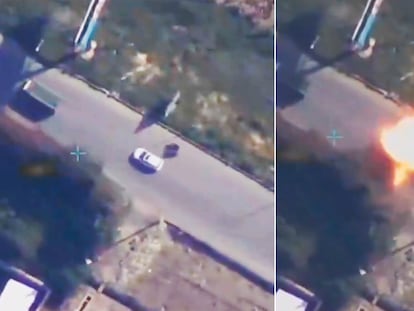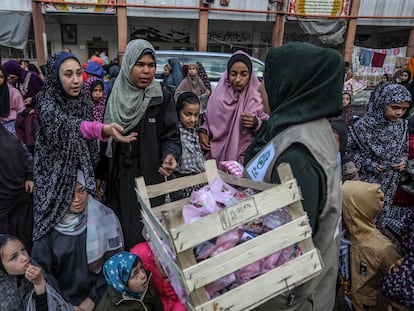Israel’s threat to invade Rafah regains strength after Iran’s attack
The Israeli armed forces have called up thousands of reservists and are preparing ‘operational activities’ in the last refuge in Gaza. Netanyahu can now frame the ground offensive as punishment for Tehran’s actions

The leaflets are printed. The Israeli army had planned to drop them on Rafah this week, to order more than half of Gaza’s 2.3 million inhabitants to abandon their last precarious refuge, according to Israeli public radio. Shortly before, the Israeli Ministry of Defense had published a public tender to acquire 40,000 tents that can accommodate 480,000 people, 12 in each one. Then came Iran’s unprecedented attack against Israel on Saturday, and Israeli Prime Minister Benjamin Netanyahu backed down, not wanting to upset the United States, the ally that had shot down most of the drones and missiles launched by Tehran and called plans to invade Rafah “a big mistake.”
Since announcing the ground offensive against Rafah almost two months ago, Netanyahu has used the threat as a decoy, as a tool of psychological warfare — “there is a date,” he warned last week — as a means of pressuring Hamas to soften its stance in the negotiations for a ceasefire and prisoner swap for hostages, as a way of keeping his ultranationalist partners happy and, above all, as the last stage of the “absolute victory” that he says is “within reach.”
The sword of Damocles has fallen a few inches. The army has called up thousands of reservists for “operational activities on the Gazan front” and Defense Minister Yoav Gallant met on Monday to discuss “a series of measures to be taken in preparation for operations in Rafah, with an emphasis on the evacuation of civilians and the expansion of activities related to the delivery of food and medical equipment to Gaza.”
The ground invasion of Rafah could now become part of Israel’s way of responding to Tehran, which it blames for the surprise Hamas attack last October that sparked the war in Gaza. A total of 44% of Israelis are in favor of the Israel Defense Forces (IDF) invading Rafah, even if it strains relations with the United States, compared to 25% who are against and 31% who are undecided, according to a poll released this Monday by the Hebrew University of Jerusalem.

In February, Christopher Lockyear, the secretary general of Doctors Without Borders (MSF), warned the United Nations Security Council that people in Rafah were living “in fear of an invasion” and called for an immediate ceasefire. A month later, he went to Rafah for four days to examine projects in Gaza and see the situation on the ground. He came back with this conclusion: “A ground offensive in Rafah would be absolutely horrible. Carnage.” He made these comments to EL PAÍS, after returning from Gaza and before Iran’s attack, at the NGO’s headquarters in the Palestinian neighborhood of Shuafat, in East Jerusalem.
Lockyear insisted that the problem does not lie in how to manage a ground offensive, with troops and armored vehicles, in such a crowded place, but the very idea itself: “I don’t see any scenario concerning the ground invasion of Rafah that is not catastrophic.” Due to the prevailing chaos and the constant movement of the population, it is not clear how many people are living in the city, trying to survive. The United Nations estimates the figure at between 1.4 and 1.5 million, most of whom have been displaced from other parts of Gaza, in some cases, several times. “All the roads are lined with tents and makeshift shelters. A trip that used to last 10 minutes now lasts an hour,” said Lockyear.
Rafah is in the south of Gaza, on the border with Egypt. It is exactly where the Israeli army ordered the than one million inhabitants of the north to go to at the beginning of the war. The buildings they lived in before are today largely rubble or uninhabitable. Added to this is the dire humanitarian crisis that is ravaging Gaza, despite the recent entry of more aid, as the United States reported on Monday, after it forced Israel to relax the use of hunger as a weapon of war following the international outrage over the murder of seven humanitarian workers from chef José Andrés’ NGO, World Central Kitchen. In other words, people who have been hit the hardest have fewer places to return to than when they first left their homes five months ago.

“No possibility”
Lockyear, a 44-year-old Briton, believes it is practically impossible to displace all the Palestinians in Rafah. And, even if it were, he clarifies, it would take a heavy toll on their health. “I spoke to people who have been displaced two, three, four times in the last few months. One of the possibilities being talked about is taking people to a beach, which is very narrow. No running water, no hygienic conditions, no toilets… It is completely absurd to think that you can move 1.5 million people safely without seriously damaging their health. I can’t see any feasible possibilities,” he said.
Hospitals, already beyond their capacities, wouldn’t be able to cope either. Lockyear visited several centers on his trip. He went to one of them — Al-Aqsa in Deir al-Balah, in the center of the Gaza Strip — after a night of intense bombing in the area. He said that he didn’t dare count the number of bodies in the hospital morgue, and that the center was packed with displaced people, with the corridors “full on both sides with people waiting for their wounds to be dressed.” “It was hot, it was dark and I was avoiding stepping on people because of the high density of patients,” he said.
That area of Gaza was already suffering from health shortages before the war. Now, says Lockyear, the pediatric department has been faced with terrible dilemmas such as deciding whether to allocate the beds to those injured by bombings or to patients with malnutrition, because there were not enough beds for everyone.
Sign up for our weekly newsletter to get more English-language news coverage from EL PAÍS USA Edition
Tu suscripción se está usando en otro dispositivo
¿Quieres añadir otro usuario a tu suscripción?
Si continúas leyendo en este dispositivo, no se podrá leer en el otro.
FlechaTu suscripción se está usando en otro dispositivo y solo puedes acceder a EL PAÍS desde un dispositivo a la vez.
Si quieres compartir tu cuenta, cambia tu suscripción a la modalidad Premium, así podrás añadir otro usuario. Cada uno accederá con su propia cuenta de email, lo que os permitirá personalizar vuestra experiencia en EL PAÍS.
¿Tienes una suscripción de empresa? Accede aquí para contratar más cuentas.
En el caso de no saber quién está usando tu cuenta, te recomendamos cambiar tu contraseña aquí.
Si decides continuar compartiendo tu cuenta, este mensaje se mostrará en tu dispositivo y en el de la otra persona que está usando tu cuenta de forma indefinida, afectando a tu experiencia de lectura. Puedes consultar aquí los términos y condiciones de la suscripción digital.
More information
Archived In
Últimas noticias
Raúl Rocha, from jet-setting with Miss Universe to arms trafficking and fuel theft
80,000 barrels of Mexican oil sent to Cuba: Havana drawn into the US–Mexico clash
Human rights activists, opposition members, and a minor: Maduro’s other political prisoners
Israel sparks a civil war within the MAGA movement
Most viewed
- Reinhard Genzel, Nobel laureate in physics: ‘One-minute videos will never give you the truth’
- Pablo Escobar’s hippos: A serious environmental problem, 40 years on
- Charles Dubouloz, mountaineering star, retires at 36 with a farewell tour inspired by Walter Bonatti
- Why we lost the habit of sleeping in two segments and how that changed our sense of time
- The fall of a prolific science journal exposes the billion-dollar profits of scientific publishing











































